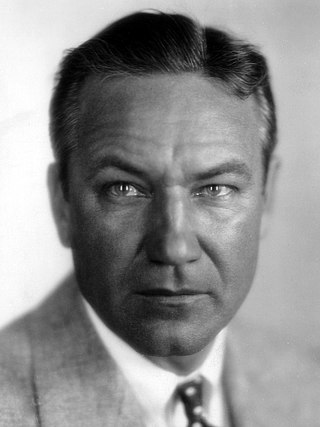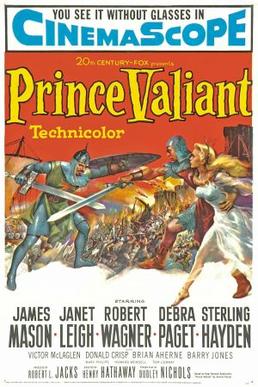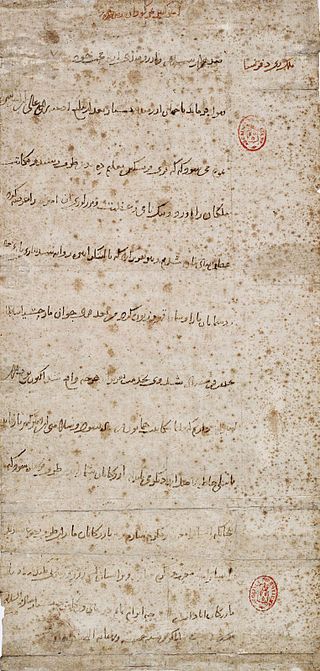
Ivanhoe: A Romance by Walter Scott is a historical novel published in three volumes, in 1819, as one of the Waverley novels. It marked a shift away from Scott's prior practice of setting stories in Scotland and in the more recent past. It became one of Scott's best-known and most influential novels.

Joseph Cheshire Cotten Jr. was an American film, stage, radio and television actor. Cotten achieved prominence on Broadway, starring in the original stage productions of The Philadelphia Story (1939) and Sabrina Fair (1953). He then gained worldwide fame for his collaborations with Orson Welles on three films, Citizen Kane (1941), The Magnificent Ambersons (1942), and Journey into Fear (1943), for which Cotten starred in and was also credited with the screenplay.

George Orson Welles was an American actor, filmmaker, and magician who is remembered for his innovative work in film, radio, and theatre. He is considered to be among the greatest and most influential filmmakers of all time.

Thomas Bertram Costain was a Canadian-American journalist who became a best-selling author of historical novels at the age of 57.

Victor Lonzo Fleming was an American film director, cinematographer, and producer. His most popular films were Gone with the Wind, for which he won an Academy Award for Best Director, and The Wizard of Oz. Fleming has those same two films listed in the top 10 of the American Film Institute's 2007 AFI's 100 Years...100 Movies list.

Cathay is a historical name for China that was used in Europe. During the early modern period, the term Cathay initially evolved as a term referring to what is now Northern China, completely separate and distinct from China, which was a reference to southern China. As knowledge of East Asia increased, Cathay came to be seen as the same polity as China as a whole. The term Cathay became a poetic name for China.

Tyrone Edmund Power III was an American actor. From the 1930s to the 1950s, Power appeared in dozens of films, often in swashbuckler roles or romantic leads. His better-known films include Jesse James, The Mark of Zorro, Marie Antoinette, Blood and Sand, The Black Swan, Prince of Foxes, Witness for the Prosecution, The Black Rose, and Captain from Castile. Power's own favorite film among those that he starred in was Nightmare Alley.

John Edward Hawkins, CBE was an English actor who worked on stage and in film from the 1930s until the 1970s. One of the most popular British film stars of the 1950s, he was known for his portrayal of military men.

Henry Hathaway was an American film director and producer. He is best known as a director of Westerns, especially starring Randolph Scott and John Wayne. He directed Gary Cooper in seven films.

Bento de Góis, was a Portuguese Jesuit missionary and explorer. His name is commonly given in English as Bento de Goes or Bento de Goës; in the past, it has also been Anglicized as Benedict Goës.

Bratton Fleming is a large village, civil parish and former manor in Devon, England, about 6 miles (10 km) north-east of Barnstaple and near the western edge of Exmoor. The parish includes the hamlets of Knightacott and Stowford. The population of the parish in 2001 was 942, falling to 928 in 2011. There is an electoral ward with the same name which at the 2011 census had a population of 2,117.
Walter Scharf was an American musician, best known as a film, television and concert composer and arranger/conductor.

Prince of Foxes is a 1949 American historical adventure film adapted from Samuel Shellabarger's novel Prince of Foxes. The movie starred Tyrone Power as Orsini and Orson Welles as Cesare Borgia. It was nominated for two Oscars during the 22nd Academy Awards: Best Black and White Cinematography and Best Costume Design, Black and White.

Cécile Aubry was a French film actress, author, television screenwriter and director.

The Shepherd of the Hills is a 1941 American drama film starring John Wayne, Betty Field and Harry Carey. The supporting cast includes Beulah Bondi, Ward Bond, Marjorie Main and John Qualen. The picture was Wayne's first film in Technicolor and was based on the novel of the same name by Harold Bell Wright. The director was Henry Hathaway, who directed several other Wayne films including True Grit almost three decades later.
Bayan of the Baarin, or Boyan, was an ethnic Mongol general of the Yuan dynasty of China. He was known to Marco Polo as "Bayan Hundred Eyes". He commanded the army of Kublai Khan against the Southern Song dynasty, ushering in the Southern Song collapse and the conquest of southern China by the Yuan dynasty.

Prince Valiant is a 1954 American adventure film directed by Henry Hathaway and produced by Robert L. Jacks, in Technicolor and Cinemascope, produced and released by 20th Century-Fox. Based on the King Features syndicated newspaper comic strip of the same name by Hal Foster, the film stars James Mason, Janet Leigh, Robert Wagner, Debra Paget and Sterling Hayden.

Timurid relations with Europe developed in the early 15th century, as the Turco-Mongol ruler Timur and European monarchs attempted to operate a rapprochement against the expansionist Ottoman Empire. Although the Timurid Mongols had been Muslim since the early 14th century, a strong hostility remained between them and the Ottoman Turks as well as the Egyptian Mamluks.

The Black Rose is a 1945 historical novel by Thomas B. Costain. It is a fictional story set in the 13th century about a young Saxon who journeys to the far-away land of Cathay in search of fortune. Included in this narrative are several notable figures: Roger Bacon, Bayan Hundred Eyes, Edward I of England and his consort Eleanor of Castile. Costain also includes a passage depicting the building of a galere da mercato at the Venetian Arsenal in a single day.
William Marshal, 1st Earl of Pembroke was an Anglo-Norman soldier and statesman. He served five English kings – Henry II, his sons the "Young King" Henry, Richard I, and John, and John's son Henry III.


















